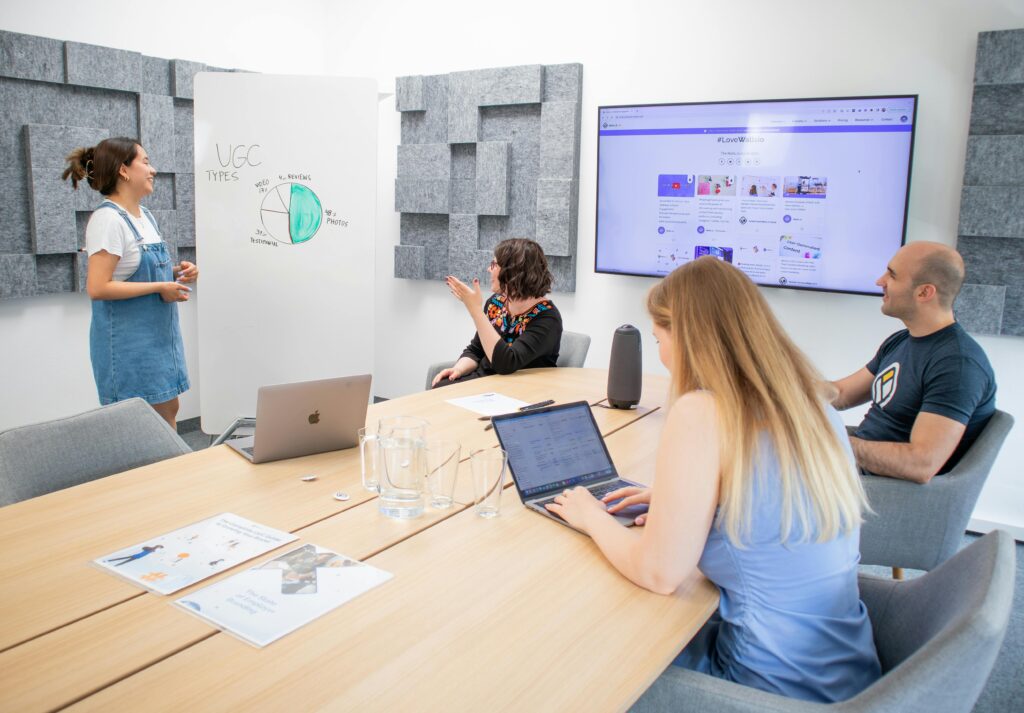Early traction is not a magic number. It is proof that your idea works in the real world. It shows that real users care, return, and tell others. It shows you can build, learn, and move fast without waste. This is what investors look for first.
What VCs Mean When They Say Traction
Traction is the chain that links your promise to repeatable outcomes. Investors are not hunting for noise; they are scanning for patterns that hold under stress.
They want to see that the same inputs from the same kind of customer keep producing the same result with less and less effort from your team. Think of it as compression. Each cycle squeezes waste out of the motion from interest to impact.
If your process becomes smoother while impact grows, that is traction in its pure form.
The most convincing proof sits where product, revenue, and risk meet. Show that a real user finished a real job with your product and that they chose to do it again without hand-holding. Show that the value survived changes in data, volume, or environment.
Show that you learned something measurable from every run and folded that learning back into the product fast. When this loop is visible, a VC can underwrite not only what you did, but what you will likely do next quarter.
Investors also test your control of cause and effect. If a demo wins deals only when a founder is in the room, you have stagecraft, not traction. If outcomes depend on a single engineer hot-fixing in the background, you have heroics, not traction.
Replace personality with process. Codify the steps, instrument the checkpoints, and make the sequence observable by anyone on the team. When outcomes persist across people and time, belief follows.
Market context matters as much as metrics. A small number that hits the heart of a painful job will often beat a big vanity count. If you automate a step that blocks revenue, a single account doubling usage tells more than a thousand casual signups.
Tie every claim to the moment money moves or risk falls. That is how investors map your traction to a durable business.
How To Turn This Definition Into Daily Practice
Start each week with a single hypothesis about value that you can prove or disprove by Friday. Define the exact user, the exact task, and the exact change you expect to see. Run the play with three accounts that fit your target.
Capture setup time, first success time, and repeat use without your help. Close the week by writing what held, what broke, and what you changed in the product because of it. This rhythm converts vague momentum into bankable proof.
Standardize your first mile. Script the path from first touch to first win so a new teammate can follow it step by step. Reduce the steps until a motivated buyer can reach value in one sitting.
Record two or three live sessions each week and rewatch them as a team. Tag the moments of friction and remove one per day. The before-and-after clips become material for sales, diligence, and training.
Translate outcomes into money and risk terms the buyer already uses. If you save time, show who uses that time and what it lets them ship sooner. If you cut errors, show the incident that no longer happens and the cost it avoided.
Keep the math plain and traceable to logs or invoices. When your numbers match the buyer’s books, investors will trust them.
Protect the engine as it hardens. File provisionals on the unique steps in your method as they emerge, especially where data flows, model logic, or motion control create the edge. This keeps fast learning from becoming easy copying.
If you want a partner who embeds IP work inside your traction loop, apply at https://www.tran.vc/apply-now-form/.
The Signals That Matter Most In The First Mile
Clear pain, clear user, clear job
VCs look for a crisp problem. They want to know who hurts, when they feel it, and what they try today. If you can state the job in one short line, you are on track. The best early traction shows that the same job shows up across many users in the same way.

That means you can sell one fix many times.
Great founders collect proof fast. They talk to users every week. They track the same few questions. They run small tests that give yes or no answers. They write down what changed and why.
When you share this with a VC, it reads like a story. The cast is real. The plot moves. The ending is not vague.
Time to value that is short and sharp
Early users do not wait months to feel a win. Strong teams cut the first time-to-value down to a day, an hour, or even minutes. If your tech is heavy, you still find a way. You pre-train a model.
You ship a hosted demo with real data masks. You run a pilot with narrow scope. The point is to let the user feel the fix fast.
You can show this with a timeline. Day zero to setup done. Setup to first result. First result to repeat use. Keep each gap tight. VCs read that and see a product that will sell.
Retention as the core proof
Retention is the real vote. If a user stays and uses, the rest will follow. In the first months, do not chase big counts. Chase deep use. Track simple cohorts. Week one users, week four users, week eight users. Are they still here.
Are they using more. Are they paying more. Keep the math plain. A flat or rising use curve is gold.
If you sell to teams, watch how the product spreads inside the first account. One user to three. One team to two teams. One site to two sites. Expansion inside one logo says more than ten random signups.
A price that feels light for the value
You do not need fancy pricing. You need a price that makes the buyer nod. Show the cost you take out, or the time you give back, or the new revenue you make possible. Tie price to that.
If your price feels fair and clear, the close gets easy. Early traction here looks like quick wins with little pushback. It also looks like users moving up to a bigger plan after a short time.
A repeatable way to win a deal
Investor trust grows when your last three wins look the same. Same segment. Same entry point. Same steps to close. Same reasons to buy. This is a sales playbook in the wild.
It does not need slides. It needs proof that you can run it again next week.
Keep a deal journal. Note the first trigger. Note who you spoke to first. Note the first task you did to help. Note the blocker and how you cleared it. Note the close. When you show this, a VC sees a path to scale.
The Deep Tech Signals That Punch Above Their Weight
Design partners who do real work
Design partners are not just logos. They give time, data, and staff. They push your edge cases. They let you see the messy middle. If they meet weekly, share feedback fast, and put your tool in their real flow, that is traction.
A letter of intent helps, but the real proof is in the calendar, the commit log, and the live dashboards.
On-chain, on-robot, or in-production runs
For AI and robotics, a benchmark is nice. A live run is better. Show that your model holds up under load. Show your robot in a real site with real noise. Log uptime. Log drift. Log fail cases and fixes.
If you run behind a feature flag in a real stack, say so. If you run nights and weekends in a plant, say so. The setting matters. It says your tech is not a slide.
Data advantage that grows with use
Many teams say they have a data moat. Few can prove it. The early proof is simple. Each new customer gives you a new class of data you can learn from. Your model gets better across the board.
Your labeling cost per unit falls. Your error rate on rare cases drops month by month. These are small numbers but big signals. They tell a VC that time works in your favor.
Safety, security, and compliance ready from day one
Enterprise buyers ask about risk first. If you have a short and clear answer, you move to value faster. Show how you handle PII, how you mask data, how you sandbox access, how you log actions.
If you align to common rules like SOC 2 or ISO, even at a lite level, say so. Early traction is a smooth security review that does not kill your deal. This is where smart IP and clear docs help. We can help you build both.

If that is a gap today, apply at https://www.tran.vc/apply-now-form/ and we will work with you on it.
IP that maps to the core loop
Patents are not vanity. They should match the core of how you create value. If your model trains in a new way, protect it. If your robot arm uses a new kind of motion path that saves time and wear, protect it.
If your system stitches data in a unique pipeline that cuts cost and boosts quality, protect it. When your IP lines up with your traction, investors see a moat, not just a claim.
Tran.vc invests in-kind to get these filings done right and fast so your momentum is safe.
How To Turn Early Effort Into Evidence
Make the first mile smooth
Remove friction everywhere. Cut setup steps. Pre-fill fields. Ship defaults that work out of the box. Offer a clear path for a 30-minute call where you set things up with the user.
Record that session. Take notes. Pull out the moments where the user smiles or breathes out. These are your value moments. Build more of them. Tell that story when you pitch.
Track a handful of simple metrics
Pick a few numbers that match your job-to-be-done. If you save time, track minutes saved per user per week. If you raise quality, track errors per unit. If you bring new revenue, track dollars per seat per month.
Keep it boring and steady. Build a small dashboard. Look at it daily. Share it with design partners weekly. This steady drumbeat is traction.
Find the fastest cut to wow
Do not try to show everything. Find the one thing that makes a buyer say yes. For AI, it might be one high-risk task done on autopilot with human check. For robotics, it might be one step in the line that now runs without a stall.
Put all your energy into making that one thing crisp and safe. Once buyers feel that, they will ask for the rest.
Keep your message short and direct
Early buyers do not have time for long decks. Write a one-page brief. Who you serve. The problem in one line. The fix in one line. The proof in two lines. The ask in one line. Share this with every new lead.
If the brief lands, your calls land. If it does not, change it and try again. That change log is also traction. It shows you listen and adapt.
Close the loop with fast product updates
The best founders turn feedback into features in days, not months. Keep a public change log. When a user asks for a thing, ship a step toward it fast. Mention them in the note. Send a short clip of the fix in action.
This builds trust. It also turns users into fans who refer others. Referrals are a strong form of traction. They say your value is clear and your team is responsive.
What Early Revenue Should Look Like
Quality over quantity
In the first months, a small set of paying users is ideal. Think a handful of teams who pay a fair price and use the product often. This reduces chaos and keeps your learning tight.

Each account should have a clear owner on your side. You should meet often, and you should map use back to results.
Clean contracts and short cycles
Aim for a simple agreement. Clear scope. Clear start and end. Clear success marks. If you can close in weeks, not quarters, you are on the right track. Track each step from first call to invoice.
Remove steps that do not add value. This will shorten your cycle and let you grow with a small team.
Early proof of expansion
If a customer expands in the first two months, that is a strong sign you priced well and the value is real. Show this with a simple note. Start with five seats, now ten. Start with one site, now two.
Start with a pilot, now production. These steps paint a picture of future growth that is easy to believe.
Healthy payback
If you spend to get a user, show how fast you earn it back. Keep your spend low with founder-led sales and warm intros. If your payback is under a few months, call it out. VCs will see a path to efficient scale.
If you need help shaping this, we can work with you on pricing and structure. You can apply at https://www.tran.vc/apply-now-form/ and we will dig in with you.
Why IP Traction Multiplies Everything
It turns learning into assets
You learn fast in the first mile. Do not leave that value on the floor. When a new method, workflow, or system emerges, capture it. A strong provisional filing can cover the core while you keep building. Later, you can refine and file fully.
This turns your hard-won insights into property. It also helps in sales. Buyers see that your secret sauce is not easy to copy.
It builds confidence with big buyers
Large firms look for signs that a vendor will last. IP is one of those signs. It shows you are serious. It gives them comfort that they are not betting on a toy. It can also help with partner deals.
If your method is unique, a bigger player may want to bundle or license, which can open distribution before you build a large team.
It sharpens your story
When you state the claims in a patent, you refine your language. You name the key parts. You define the edges. This makes your pitch tighter. It also helps guide the roadmap. If a claim covers a core loop, you know where to invest.

If a feature is outside the core, you can cut it without fear.
At Tran.vc, we make this process simple. We place expert patent work right inside your early build. You keep control, and you move faster because your moat grows as your product grows. If that sounds right for you, start here: https://www.tran.vc/apply-now-form/.
How To Design Proof That Feels Real
Real proof happens in the wild. It runs on real data, under real load, with real limits. Treat every proof like a small slice of production. Use the same login paths, the same data rules, and the same alerts you will need later.
If the setup needs a special script or a hidden switch, fix the product until that step is gone. The goal is to show value with the same motion a normal user will follow next month.
Anchor the proof to a single business moment. Pick one job where money moves or risk drops. State the start, the finish, and the test you will use to call it done. Replace soft claims with facts that live in the logs.
If you save time, capture the time before and after from system data. If you cut mistakes, count the ones caught by your tool and trace them to the source. When every claim maps to a record, the proof stands on its own.
Design for contrast, not theater. Run your method next to the current way for a short window. Keep inputs the same. Keep staff the same. Only the tool changes. When the result is better with your tool and the buyer can see it on their screen, doubt falls away.
If you cannot run a clean side-by-side, use a short shadow mode. Let your system watch, predict, and log, while the team still works the old way. Share the mismatch cases first. They are where trust grows.
Plan for failure with intent. Before the run, write a short pre-mortem. Name three ways the proof might break and the signals that will tell you it is breaking. Set simple stop rules so you do not burn goodwill.
When a fail happens, show the signal, show the stop, and show the fix. Calm control beats flashy speed.
Use a tight consent path for data. Keep only what you must. Mask what you can. Limit who can see raw inputs. Show this to the buyer in one page. When legal and security see care and clarity, they clear the path faster.
This is also where good IP hygiene starts. As new steps in your method prove out, capture them in dated notes, diagrams, and small filings. It turns learning into owned ground.
Action Steps You Can Run This Month
Pick one high-value job and define a proof window that lasts two weeks. Write a one-page brief with goal, start, finish, data rules, and stop rules. Build a lightweight dashboard that shows three things only: time to first success, repeat use without help, and the main outcome tied to money or risk.
Record three full sessions end to end and annotate the moments that matter. Share a short proof packet with the buyer that includes the brief, the dashboard, two clips, and a simple note on what you changed after week one.

End the window with a go or no-go, and a small paid next step if it is a yes.
If you want a partner who helps you turn this proof into a moat you own, Tran.vc invests up to $50,000 in in-kind patent and IP work so your best methods stay yours. You can apply any time at https://www.tran.vc/apply-now-form/
Conclusion
Early traction is steady proof, not noise. It is a clear line from pain to value that repeats across the same kind of customer with less effort each time. When your first mile is smooth, when value lands fast, and when outcomes survive real-world stress, investors can trust the path ahead.
When your core methods are protected with smart IP, that trust turns into leverage. You raise on your terms because you own the engine, not just the moment.
